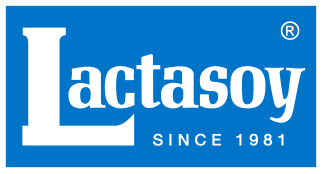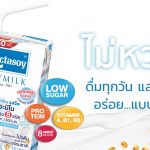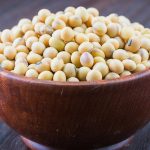Soybean II
Other common name(s):
soy, soya, soy protein, soy powder, edamame, glycine soja
Scientific/medical name(s):
Glycine max
Description
The soybean plant is an annual plant native to Southeast Asia. It has oblong pods that contain 2 to 4 seeds or beans. Soybeans are legumes, a member of the pea family, and are a source of high-quality protein. They are processed to make many foods and food additives.
Overview
In laboratory studies, animal studies, and research looking at groups of people and what they eat, certain chemical components of soy have been linked to a lower risk of breast and prostate cancer. Randomized clinical trials are needed to understand how these findings apply to cancer prevention in humans. Most studies that have shown benefit have used whole soy protein rather than soy components and extracts.
How is it promoted for use?
Soybean products are promoted for their protective properties against breast, prostate, colon, and lung cancer. The effects of soy are thought by some to be due to substances called isoflavones, although other substances may also contribute. Isoflavones are sometimes called plant estrogens or phytoestrogens because they mimic (although weakly) estrogen that is produced in humans and animals. Genistein, daidzein, and glycitein are isoflavones that are present in small amounts in other foods but are most abundant in soy.
As a protein source, soybean products are promoted as a healthier alternative to meat and as an aid to weight loss. Soy products are also used to lower cholesterol and blood pressure, and to relieve symptoms of menopause and osteoporosis. Soy protein in a diet low in saturated fat and cholesterol is also promoted as a method to help reduce the risk of heart disease.
What does it involve?
Soy can be consumed in many forms with tofu, soy milk, roasted soybeans, soy powder, and textured vegetable protein being some of the more popular. Soy protein powders and bars are available in nutrition stores and health food markets. The powders can be added to drinks or used in cooking. Soy is available as a dietary supplement in capsules or pills. Isoflavone supplements are also available, although most tests that show benefit have used whole soy protein. The amount of isoflavone varies by type of soy products. Soy protein and isoflavones are not found in soy sauce or soybean oil.
What is the history behind it?
The soybean has been used as a food source for more than 5,000 years. Today, there are more than 2,500 varieties of soybeans that are grown throughout the world. It was not until fairly recently that studies began on the potential health properties of the soybean.
Plant estrogens (phytoestrogens) were first identified in the early 1930s. At that time it was discovered that soybeans, willows, dates, and pomegranates contained compounds that were much like estrogens. Scientists began studying the role isoflavones play in reducing breast cancer risk in the 1960s. In a 1981 prospective study in Japan, researchers found that daily intake of miso, a soybean paste, was linked to lower death rates from stomach cancer in more than 260,000 men and women. Around that time, other studies on soy began to be published in the United States. In October 1999, the U.S. Food and Drug Administration (FDA) agreed to allow health claims about soy’s role in reducing heart disease on food products containing soy protein.
What is the evidence?
Some researchers believe that the isoflavones in soy, such as genistein, daidzein, and glycitein, may play a role in reducing cancer risk. A number of laboratory and animal experiments and human observational studies suggest that soy may reduce the risk of several types of cancer, including breast, prostate, ovarian, and uterine cancer. These results have not yet been reflected in human clinical trials, so no definite conclusions can be made.
Scientists believe there is enough evidence for phytoestrogens to be studied in clinical trials along with standard medical care for breast or prostate cancer. Human studies sponsored by the National Cancer Institute are under way. Large studies that looked at groups of women with high soy-based food intakes showed a lower risk of breast cancer and endometrial cancer, but there are many possible explanations other than the soy. Studies that control for these factors are needed. It is also possible that the weak estrogen-like effect of soy might be helpful in prostate cancer prevention, but again, large human studies are needed.
Some studies have suggested that the effect of soy foods on breast cancer risk depends on the age when they are consumed. It is thought that high soy intake by young women at a time when breast tissue is developing and estrogen levels are relatively high may offer some protection. However, it is unclear whether soy intake after menopause, when estrogen levels are naturally low, is of any benefit or could even be harmful.
Several clinical studies of women with breast cancer have been done to learn whether soy capsules can help with symptoms of menopause. The results have not shown any consistent improvement of symptoms such as hot flashes.
Several studies of men with prostate cancer have suggested that soy foods and/or supplements may reduce levels of prostate-specific antigen (PSA), a substance that typically increases as prostate cancer grows. In another study, while PSA levels did not decrease during soy treatment, they increased less rapidly than they had before the study began. Although these results are encouraging, further research is needed to learn whether soy products help men with prostate cancer to live longer.
Soybeans and soy foods have been shown in clinical trials to lower cholesterol and reduce blood pressure.
Choosing foods from a variety of fruits, vegetables, and other plant sources such as nuts, seeds, whole grains, and beans is likely to be healthier than eating large amounts of one type of food. The American Cancer Society’s most recent nutrition guidelines recommend eating a balanced diet with an emphasis on plant sources, which includes:
• 2½ cups of vegetables and fruit each day
• Choosing whole grains over processed and refined grains
• Limiting processed meats (like bacon, sausage, deli meats) and red meats (beef, pork, lamb)
• Balancing calorie intake with physical activity to get to or stay at a healthy weight
• Limiting alcohol intake
American Cancer Society
http://www.cancer.org/treatment/treatmentsandsideeffects/complementaryandalternativemedicine/dietandnutrition/soybean
For more information, see ACS Guidelines on Nutrition and Physical Activity for Cancer Prevention, which is online at www.cancer.org. Or you can get a copy by calling our toll-free number below.









